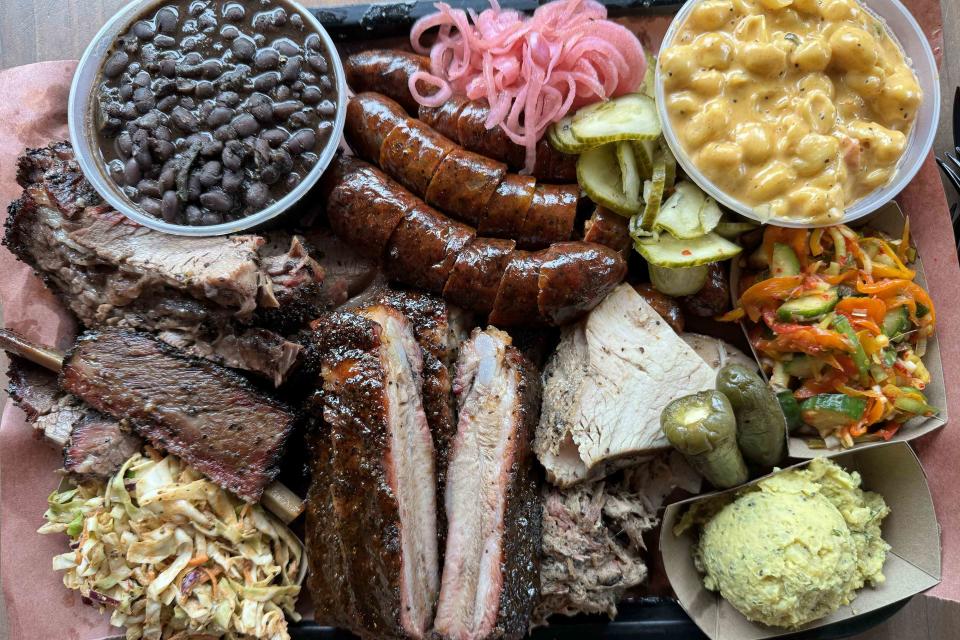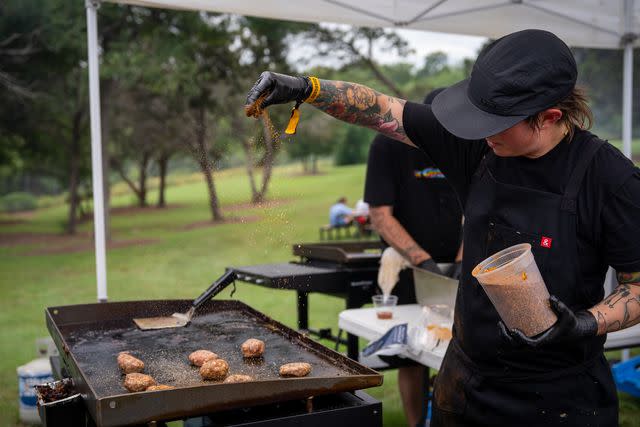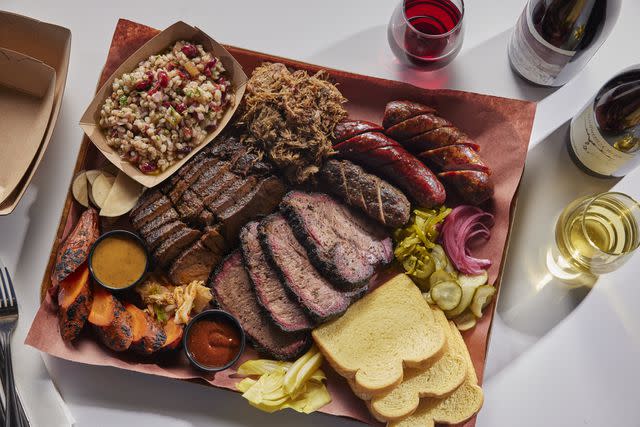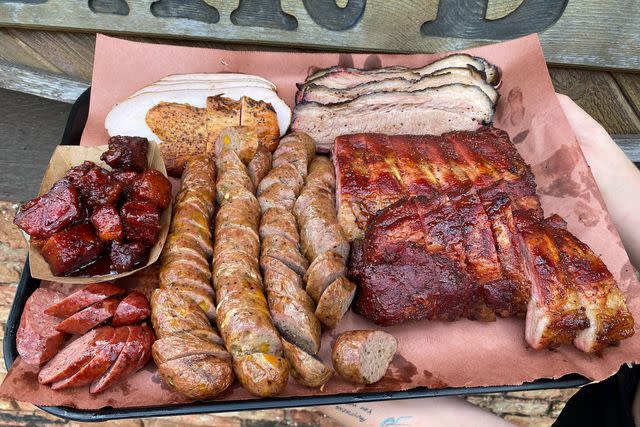An Essential Guide to Texas Barbecue
Here's where to get’cha some smoked meat in the Lone Star State.

Courtesy of La Barbecue
Backyard barbecues with beefy protagonists are about as Texan as it gets, but the tradition of Texas barbecue actually traces its roots to the state’s earliest immigrant and Native American influences. To be fair, there’s not just one type of Texas barbecue. There are four major styles across the state, where the only thing sacred is the meat … specifically the “Texas Trinity” (the actual term pitmasters have for their plates of sausage, brisket, and ribs).
Styles vary by region: East Texans sweeten their meat with a marinade before slow cooking to fall-off-the-bone doneness, West Texans prefer cooking over an open flame with mesquite wood, South Texans blend Mexican influences for a more barbacoa style, and Central Texas ‘cue gets its smoky flavor from fresh cut hardwoods like mesquite or post oak wood smoldering in an offset smoker (i.e., a smoker that utilizes indirect heat with a main chamber “offset” from the firebox).
Related: Franklin Barbecue's Aaron Franklin Explains How to Smoke a Brisket
But the style that started it all — and the style most people are referring to when talking about “Texas barbecue” — is Central Texas barbecue. The tradition dates back to the mid-19th century when German and Czech immigrants arrived and sought a means for preserving their abundance of beef. “Animals were raised and harvested for meat which was sold fresh,” explains Bryan Bracewell, owner and pitmaster of the oldest barbecue joint in the state of Texas, Southside Market & Barbeque in Elgin. “The sausage and BBQ were simply derivatives of having fresh meat and no refrigeration. It was either sold fresh or preserved to sell the next day, and smoking the sausage or the meat to make BBQ was the easiest, quickest way to preserve it to sell the next day.”
The preservation led to aspiration, and the art of Texas barbecue was born. Like many other legacy barbecue joints in the state, Southside started as a small-town German butcher shop in 1882, selling meat door-to-door from the back of a horse-drawn wagon. They eventually opened a brick-and mortar shop in 1886 to sell fresh meat in the shop and smoked meats in the back. “They weren’t restaurants, they were meat markets,” Bracewell adds.
To this day, that focus on meat is the defining trait of Texas barbecue, where the sauce will likely be served on the side as a condiment … so as not to disturb the meat until absolutely necessary, if even necessary. Beef is the obvious star in Texas (i.e., brisket, all-beef sausage, beef-blended sausage, beef ribs, etc.), but pork, chicken, and other proteins make their way onto most pits these days, too. In terms of sides, as long as there’s meat on the plate, what’s served alongside can vary. Texas sides can range from time-tested staples — like coleslaw, pickles, potato salad, fresh onions, and jalapeños — to salsas and curried vegetables or even kimchis and elotes. More often than not, you’ll be served a slice of white bread on the side — a tradition as old as the state’s original meat markets — although freshly made tortillas are gaining popularity across the state.
Related: Meet the Women at the Forefront of Texas Barbecue
In a state as big as Texas — with as many big opinions about the best in state — there’s no question that there are some necessary stops along any Texas barbecue trail. Here’s where to sample the best in Texas barbecue on a visit.
la Barbecue (Austin)

Courtesy of La Barbecue
This female-owned eatery got its start as a food truck back in 2011 when owner Ali Clem and partner LeAnn Mueller began dating and smoking meat their way. Although Mueller has since passed, Clem continues to serve up Central Texas-style barbecue with la Barbecue's signature, savory (never sweet) rubs and side dishes inspired from the couples’ world travels (i.e., quick sweet pepper cucumber Kimchi, Oaxacan-style black beans, etc.). Their three housemade sausages are local favorites — especially since they use their own pickled jalapeños to spice up their jalapeño version — but lately it’s the crispy brisket trimmings that top their award-winning sliders that have created the biggest buzz … get them during happy hour on Wednesdays and Thursdays from 3-6 p.m.
LeRoy and Lewis (Austin)

Jessica Attie / Courtesy of LeRoy and Lewis
Co-owner Evan LeRoy is the face of “New School” Texas barbecue — where the ethos is that barbecue is a method of cooking; not just a specific set of menu items — and it’s from behind his offset smoker where you’ll often see world-famous pitmasters lining up for a taste of his latest creations. A Californian by birth but Texan since the age of 5, LeRoy grew up with old-school barbecue, watching his dad work the pit in their Austin backyard. He got to put his own modern take on Central Texas-style ‘cue when he opened LeRoy and Lewis in 2017, alongside his wife Lindsey, and Sawyer and Nathan Lewis. All their meat is sourced from small, responsible purveyors in Texas, where favorite plates include beef cheeks with cauliflower “burnt ends” and a side of beet barbecue sauce and kimchi, or direct-smoked chicken with a side of onion rings dipped in white barbecue sauce.
Bodacious Bar-B-Q (Longview)

Courtesy of Bodacious BBQ
This East Texas mainstay continues to thrive even after the passing of the late founder, Roland Lindsey, thanks to his wife, Nancy, and granddaughter, Madilynne, who run the corporate business. Lindsey first opened Bodacious in 1968 off Mobberly Avenue in Longview, and today his grand-son-in-law, Spencer Halling, mans the pits of the original location, cranking out housemade sausages with a satisfying snap and saucy brisket sandwiches served chopped or sliced. The Mel-Man sandwich — a large helping of chopped brisket mixed with a chopped hot link between two buns — has become somewhat of a local legend over the years, and their Dr. Pepper burnt ends and spicy pinto beans are the winning combination and only served on Fridays or Saturdays (sometimes both days).
Southside Market & Barbeque (Austin, Bastrop, Elgin, and Hutto)
Owner and pitmaster Bryan Bracewell has a degree in meat science from Texas A&M University, but more importantly, he comes from a long lineage of pitmasters who smoked meat the original Central Texas way. Now with four locations in Texas, Southside is the oldest barbecue joint in the state and continues to stay true to their meat market roots with raw cuts to-go and smoked-to-perfection goodness sold out back. The brisket is smoked for more than 14 hours over post oak wood and can be ordered lean, moist, or mixed. They have lamb ribs, smoked turkey, and even a pork sausage stuffed with cheddar-stuffed jalapeño and wrapped in bacon, but their most-sold plate is the Texas Trinity (i.e., sausage, pork ribs, and brisket) served with pickles, white bread, and sauce on the side.
Convenience West BBQ (Marfa)
This West Texas spot went from local hang to destination restaurant seemingly overnight, where Texans and out-of-staters drive out to Marfa just to see what's smoking that weekend. [Note: Convenience West is only open Friday and Saturday, from 5 p.m. until they sell out.] Mark Scott and his wife Kaki opened the joint in 2017 with partners Adam Bork and Katy Rose Elsasser (who makes their icebox cakes and other desserts), and quickly gained acclaim for their creative sides and flavorful meats. The all-beef links and brisket tacos are local favorites, and they try to keep all of their sides vegetarian so everyone can enjoy the menu. Sides vary, and some favorites are sweet potato salad, curried green beans, and blue cornbread.
Vera’s Backyard Bar-B-Que (Brownsville)
As the only restaurant in Texas that’s still allowed to cook “en pozo” (i.e., in an underground pit), Vera’s is on a different playing field. Especially when it comes to barbacoa, its signature South Texas barbecue dish that involves slow cooking an entire cow’s head “en pozo,” then typically serving it with freshly made corn or flour tortillas and a fiery trio of salsas. The current owner, Armando Vera, has been perfecting his technique at this Brownsville restaurant since he was a teenager, helming the smoke alongside his parents, founders Alberto and Carmen Vera, before taking over. After the many state and national awards Vera’s has earned, many of the choicest parts of the head (i.e., cheeks, lips, tongue, and jaw meat) sell out soon after they open, which is often before sunrise as the restaurant only operates on weekends.
For more Food & Wine news, make sure to sign up for our newsletter!
Read the original article on Food & Wine.


